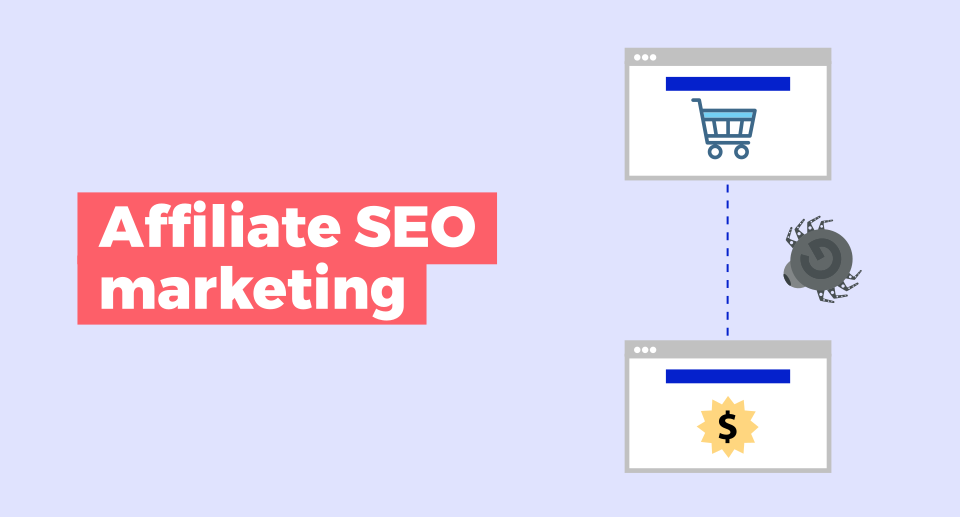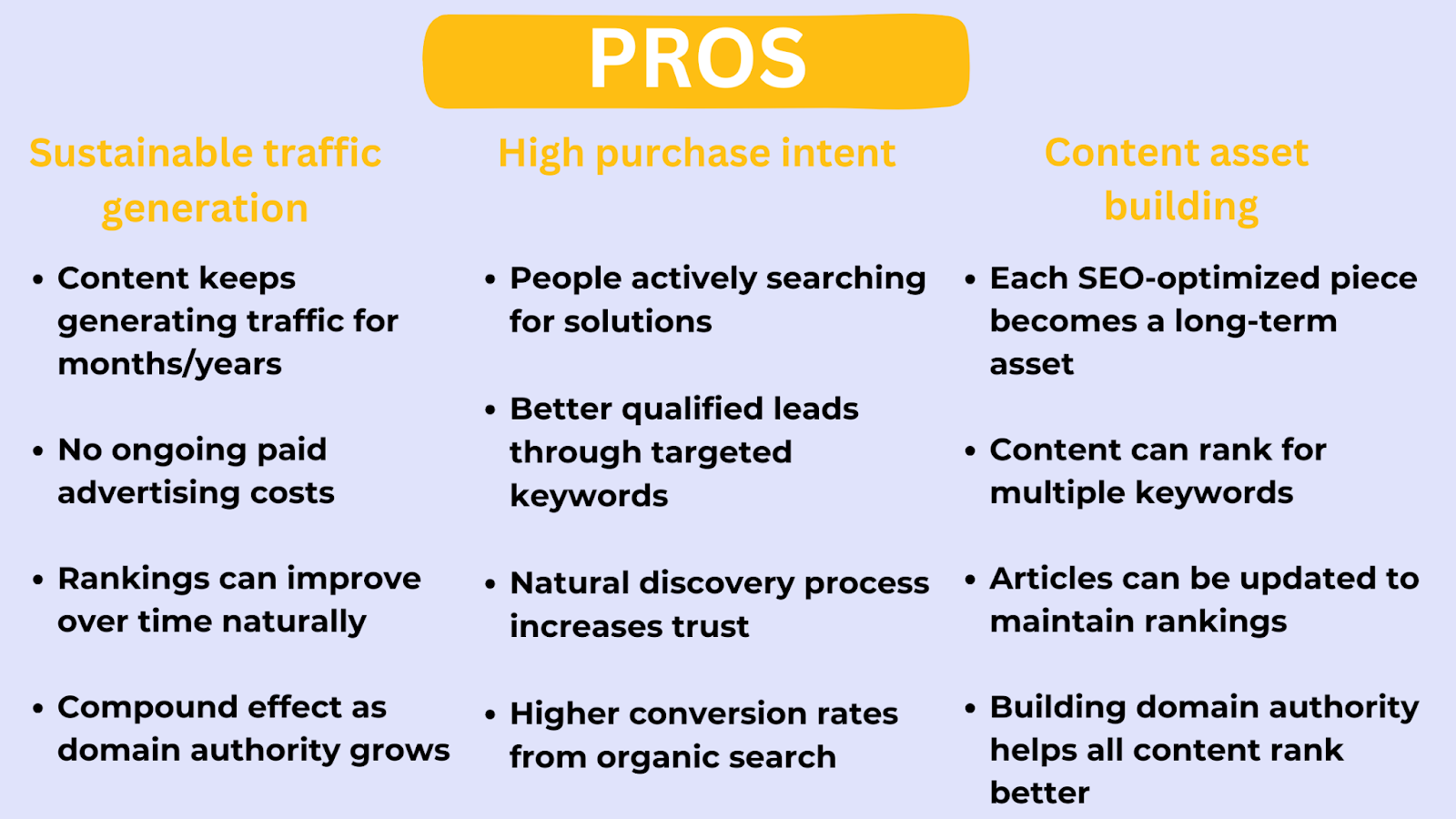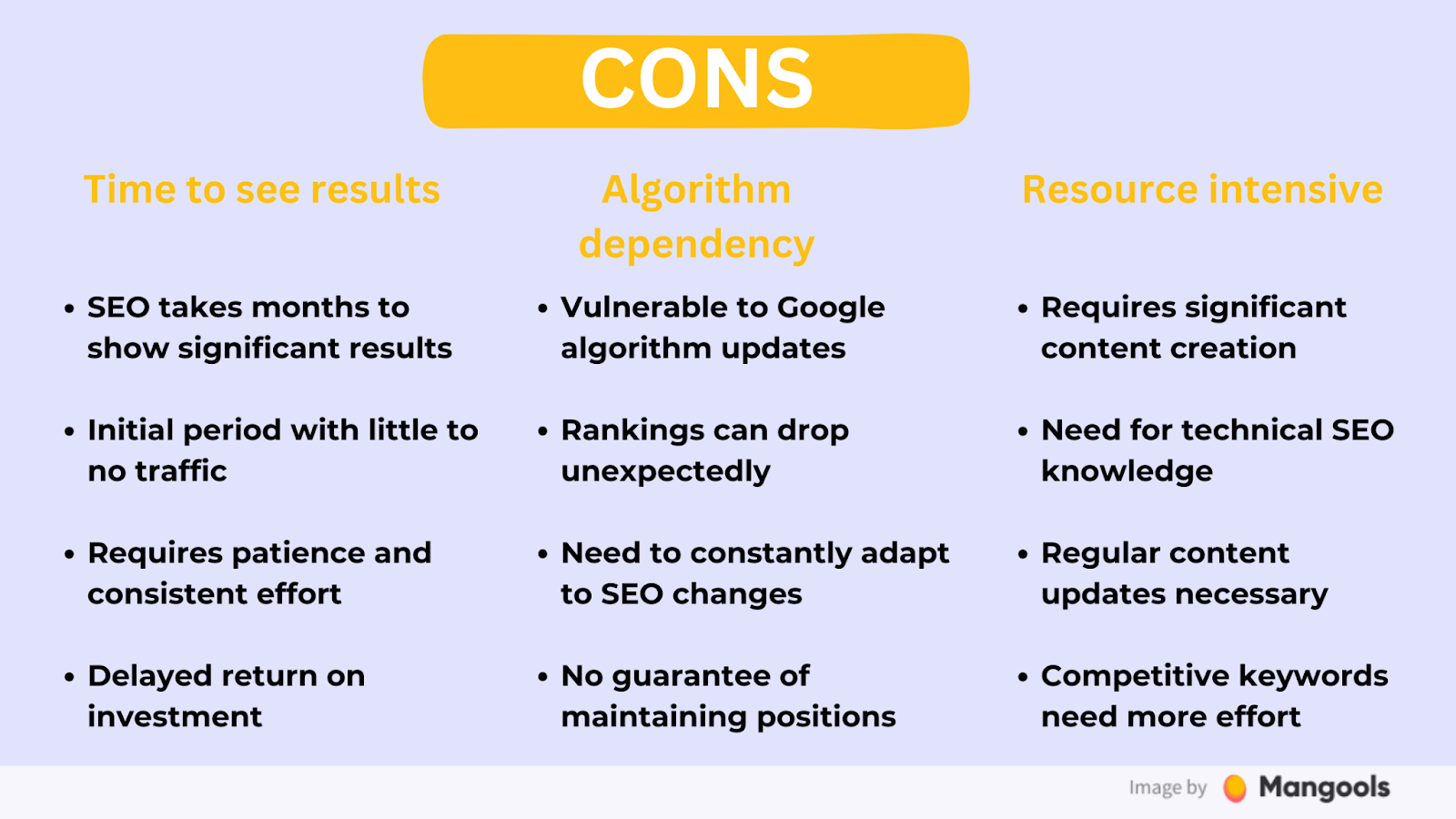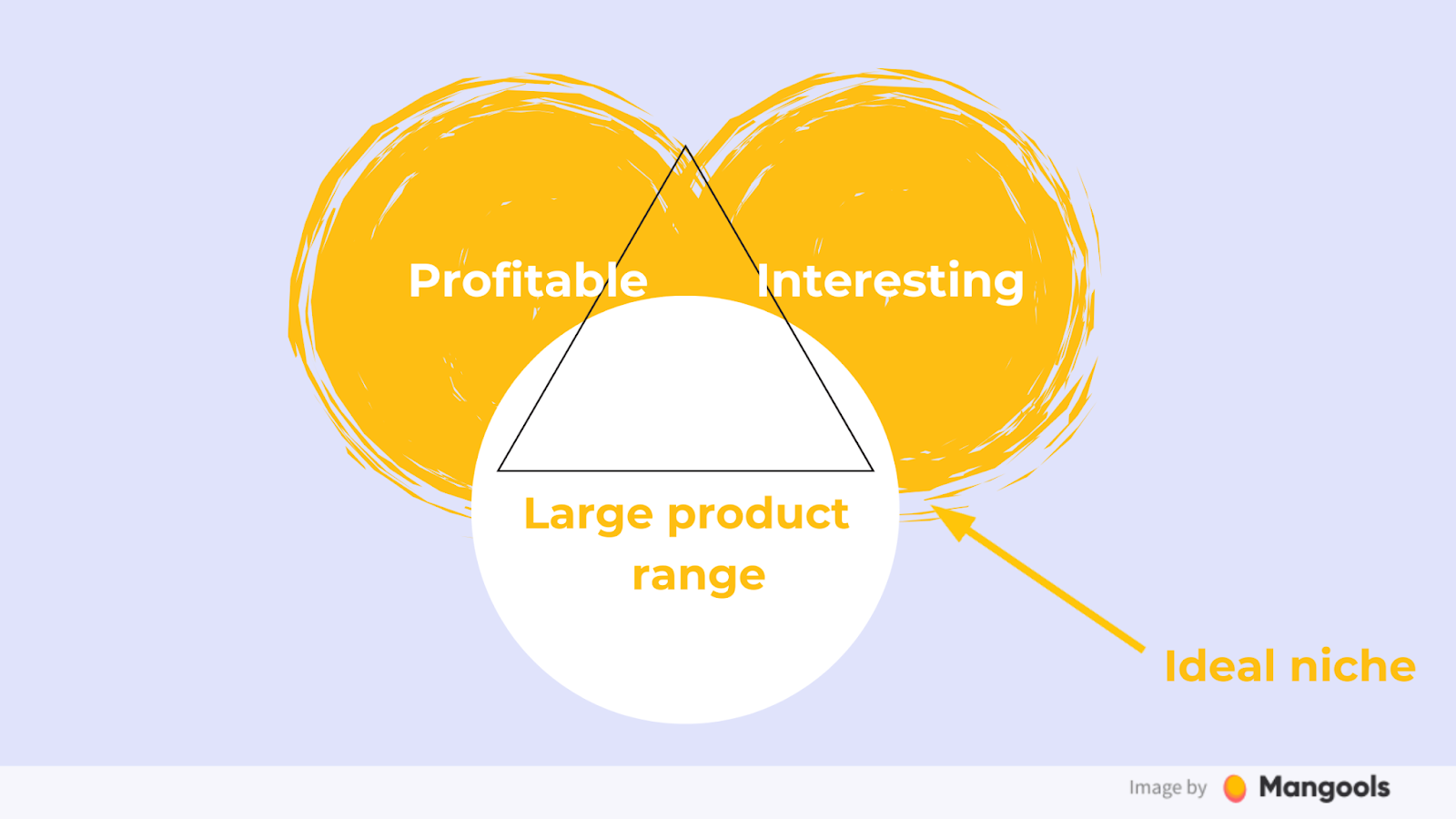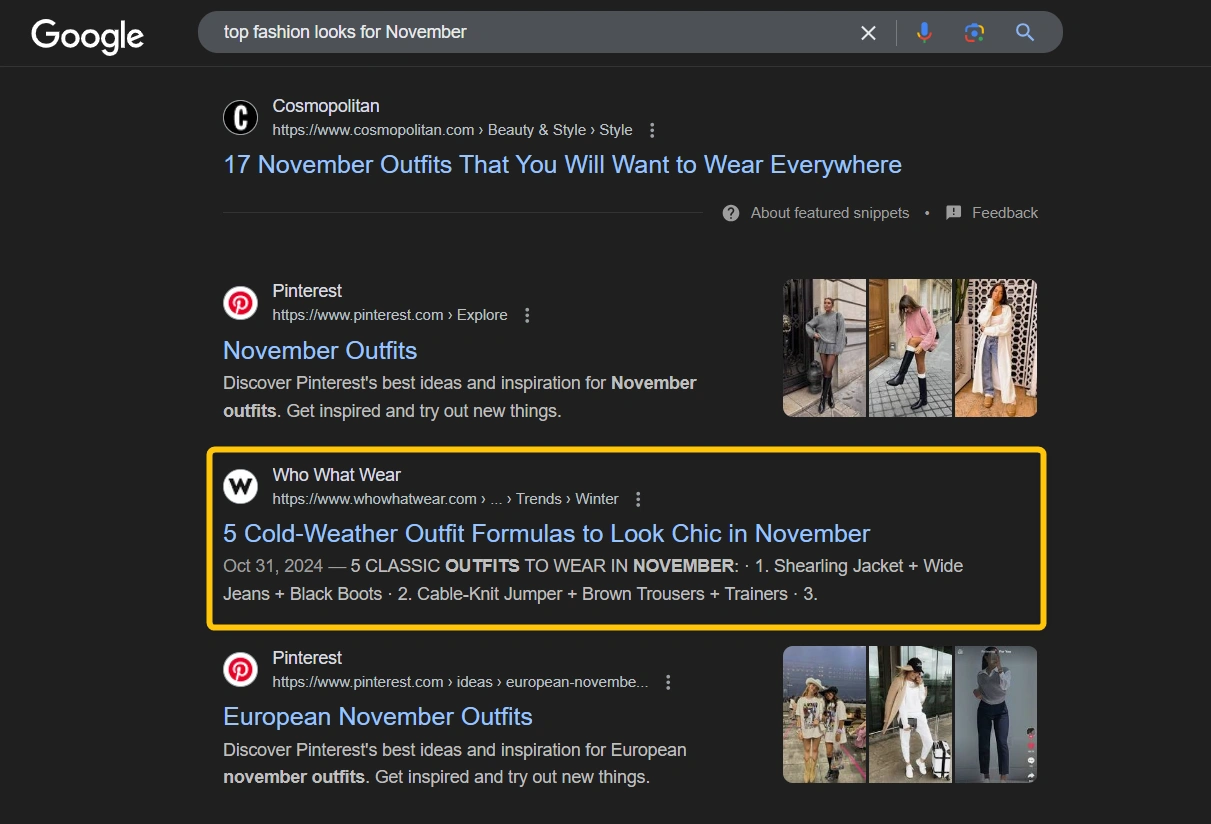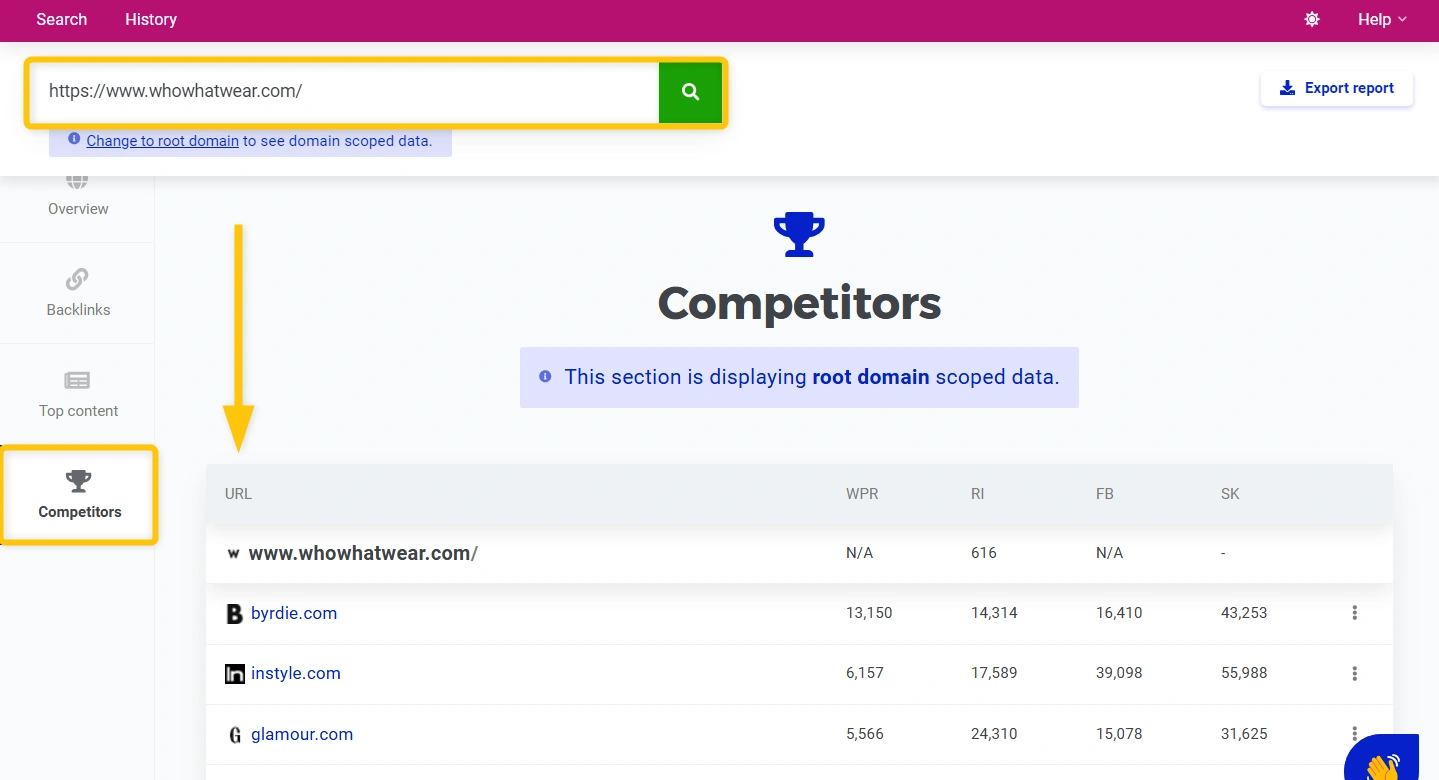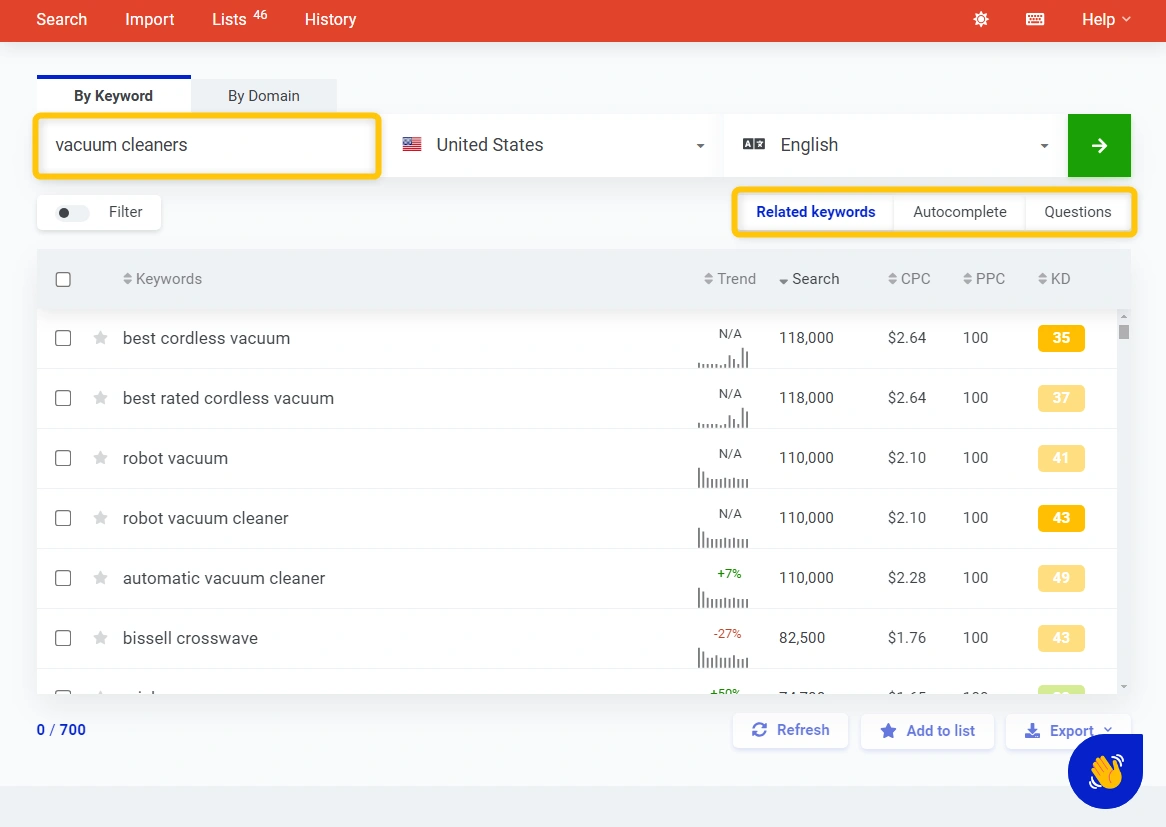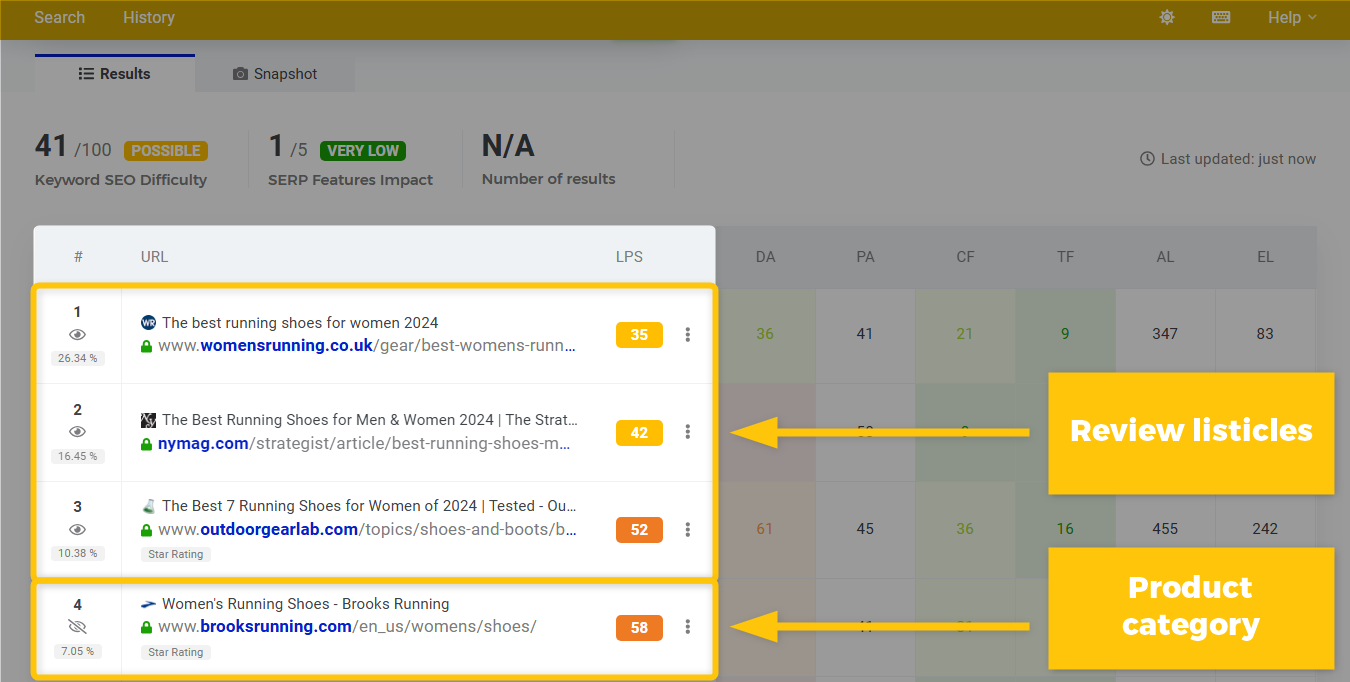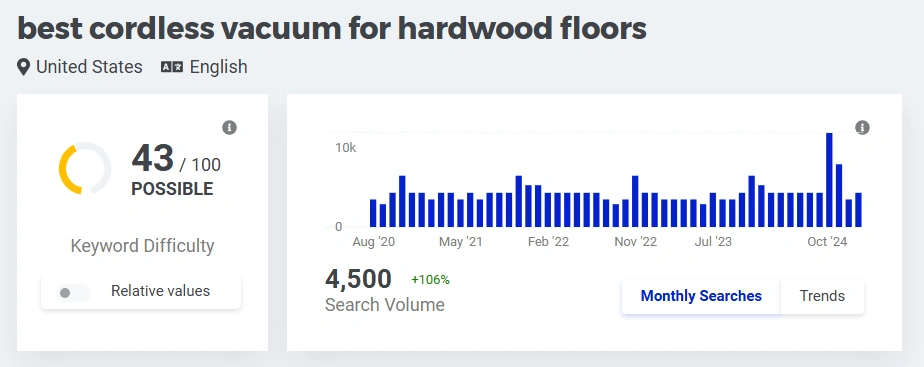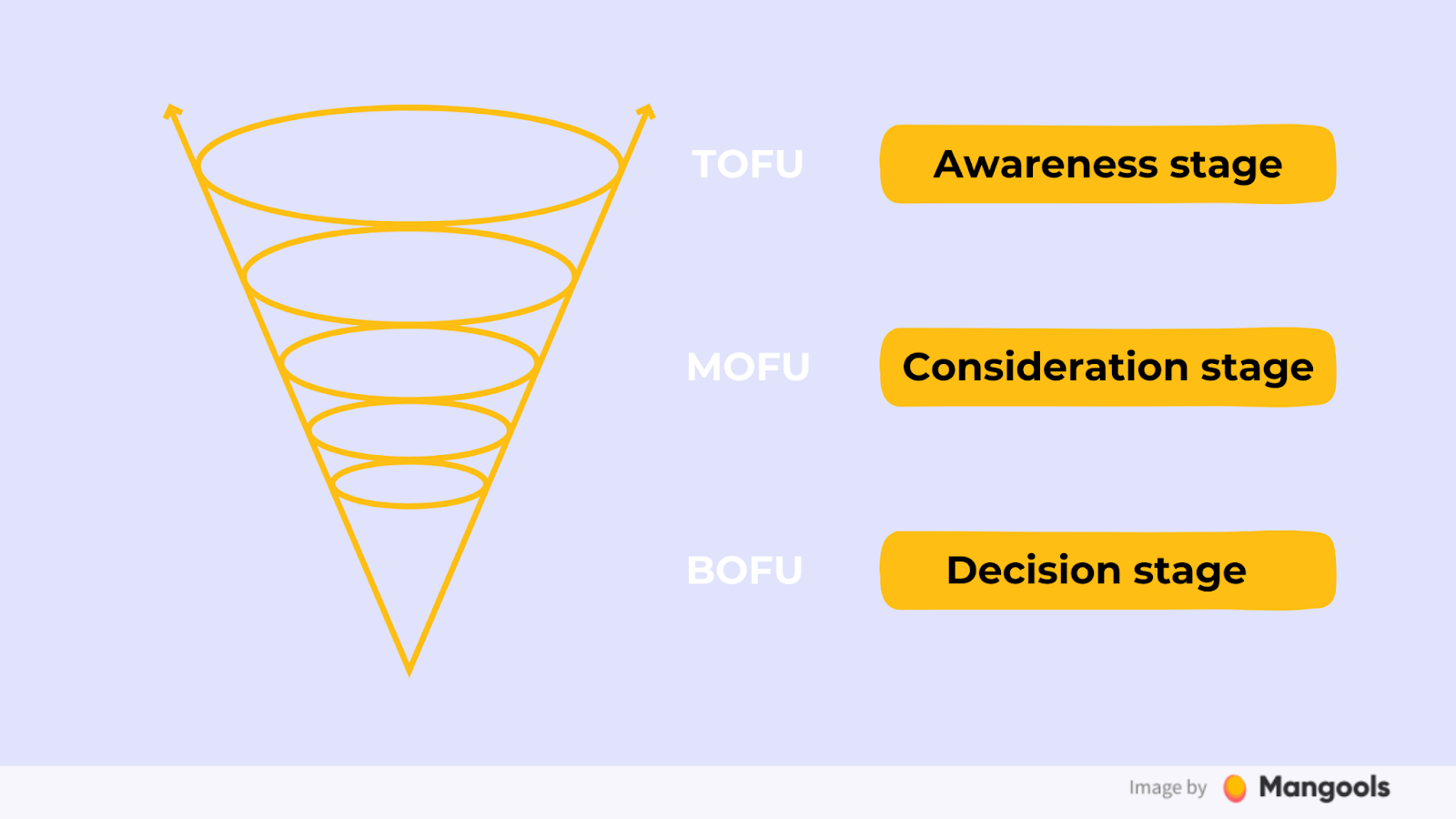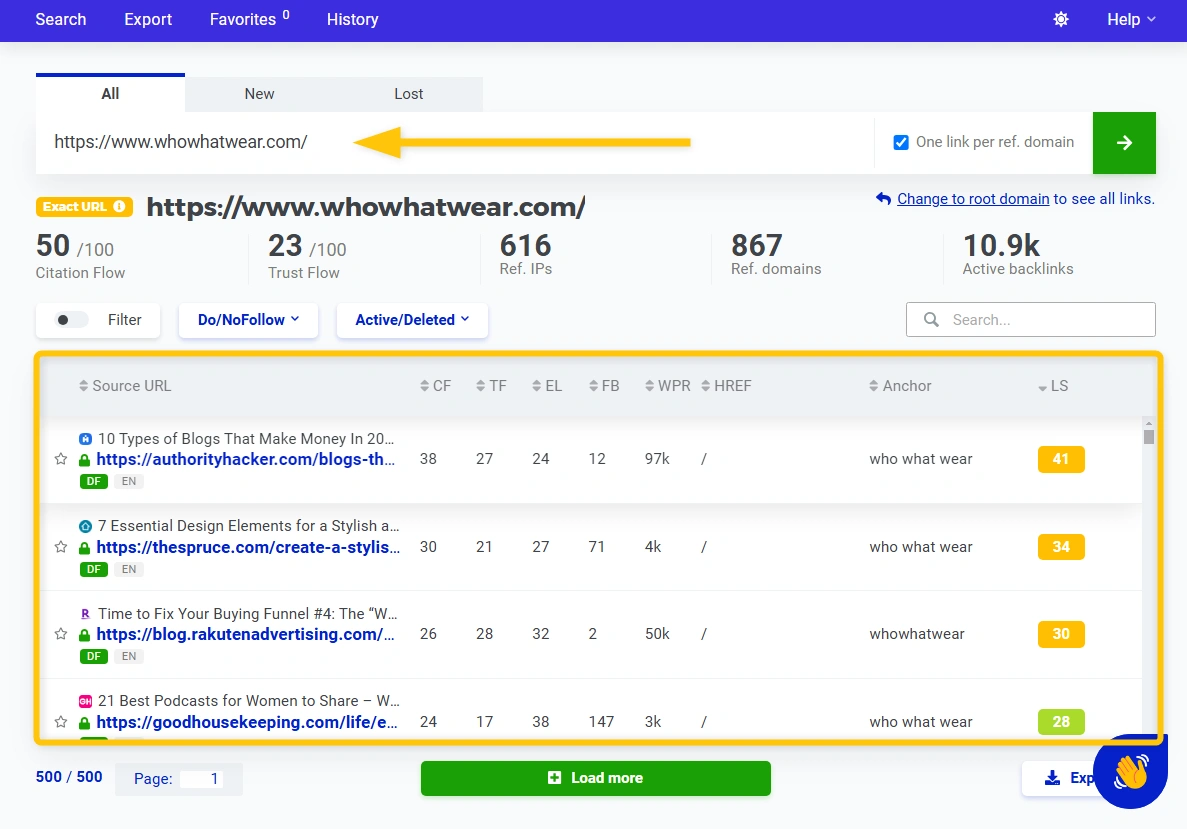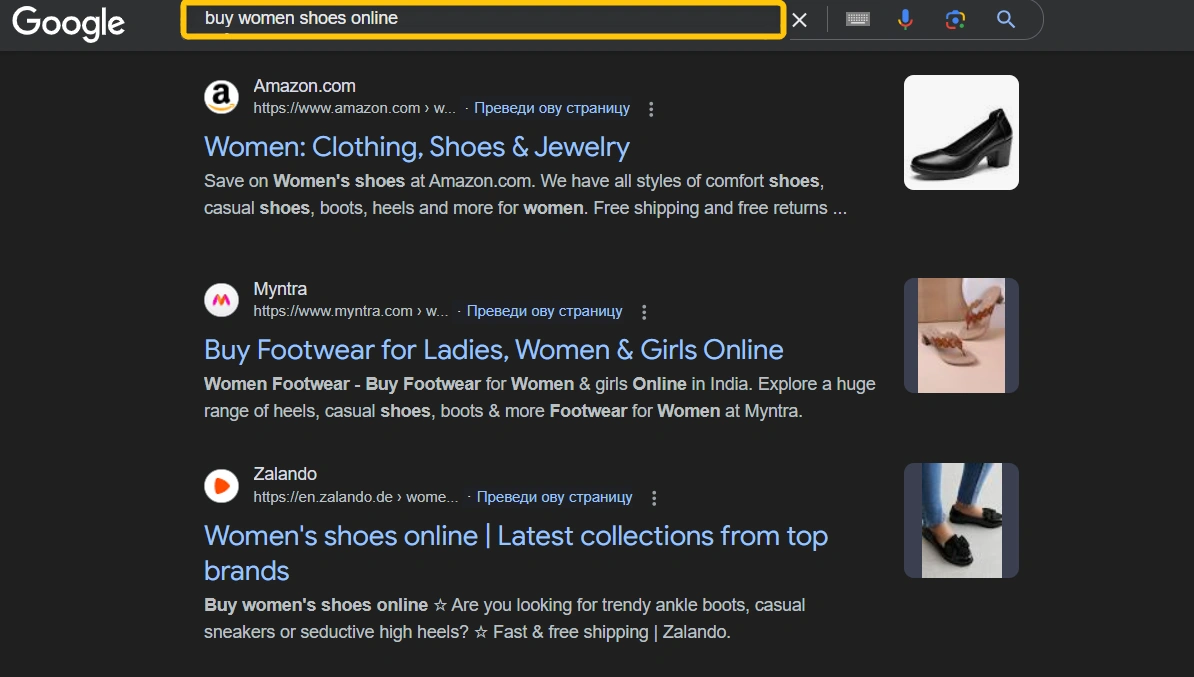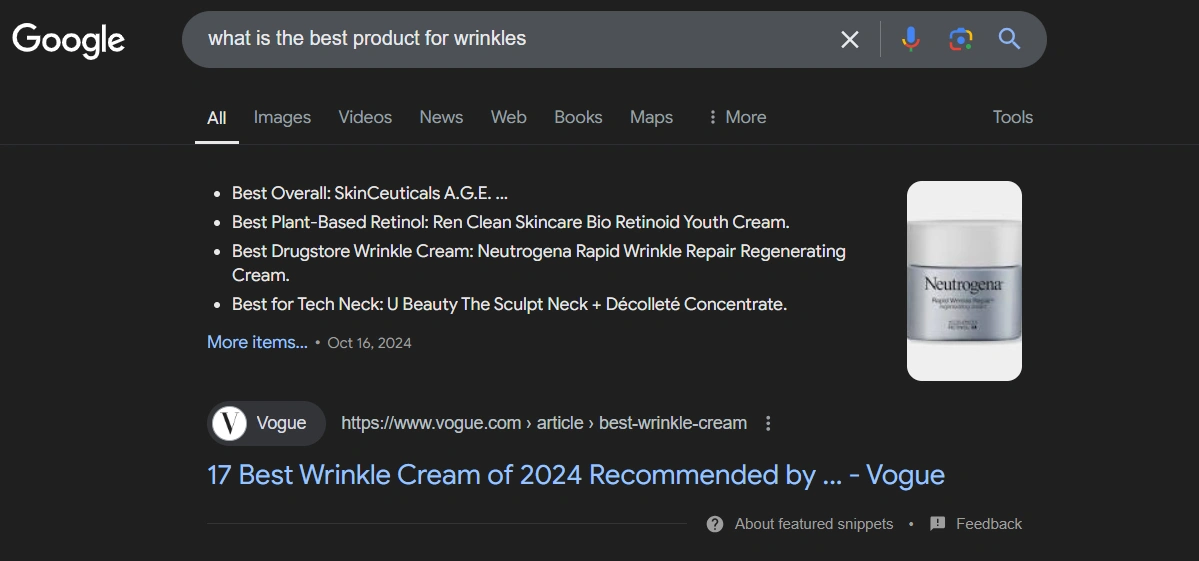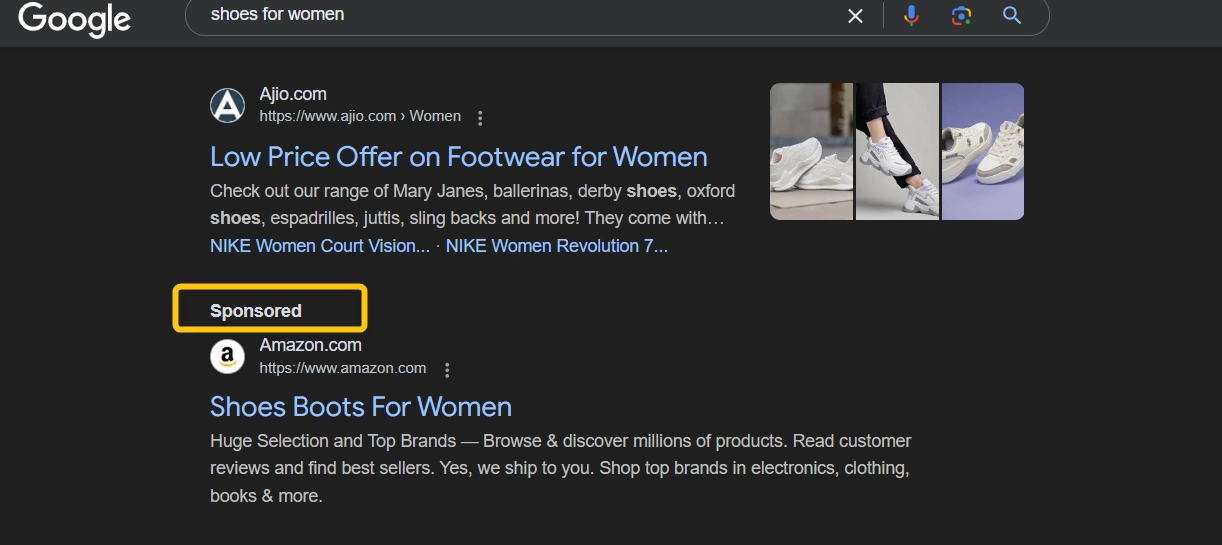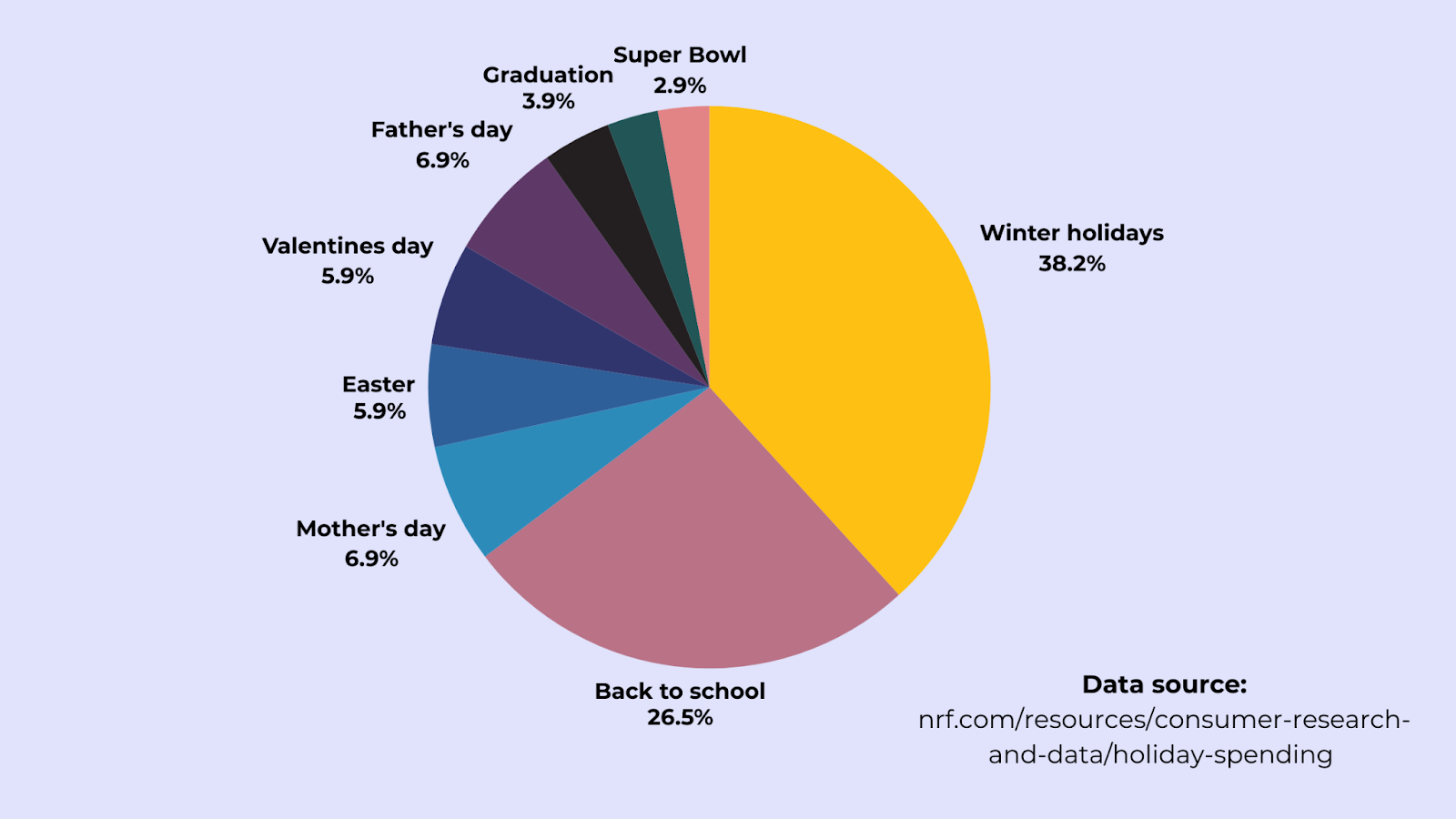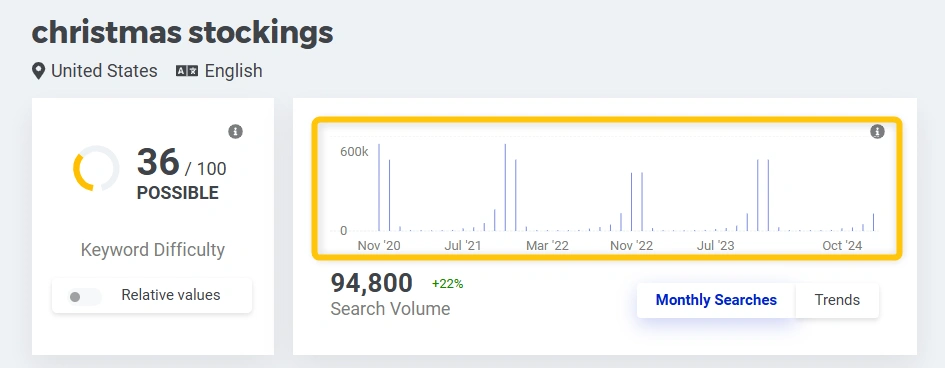To earn a commission by promoting and selling other people’s or companies’ products or services, affiliate marketers need a constant flow of traffic.
Potential customers can come from various sources such as paid advertising, email marketing, or direct referrals.
However, organic traffic offers unique advantages, as it provides a predictable revenue stream from Google Search that can lead to a stable (or even growing) income.
In this article, we will explore affiliate marketing from an SEO perspective and cover everything you need to know:
- What is affiliate SEO marketing?
- Is affiliate SEO worth it?
- How to do SEO for affiliate marketing?
- SEO tips for affiliate marketing
- Frequently asked question
What is SEO affiliate marketing?
Affiliate SEO marketing refers to a series of activities that help affiliate pages appear as top results on Google when people search for products they promote.
Investing in SEO for affiliate marketers can pay off, as even a single position jump in the SERP (search engine result page) can result in more than double clicks (which can lead to significantly more conversions).
Around 39.8% of people click on the first-page result, compared to the 18.7% that click on the second, according to FirstPageSage’s study.
SEO for affiliate marketing consists of four main pillars:
- Keyword research
- On-page SEO
- Technical SEO
- Off-page SEO
Here is a brief overview of each.
1. Keyword research
Keyword research for affiliate SEO is the process of finding out the terms your target audience uses to search for products you are promoting.
These terms (or keywords) alongside the first results on a particular search engine result page (SERP) indicate what exactly is your audience looking for: A concrete product, comparison, additional information, etc.
Not all keywords you might find interesting for your website will be worth optimizing for – some of them might be irrelevant or will not bring too much value in terms of organic clicks, leads, or conversions.
In addition to that, you have to consider also the competitiveness of some keywords.
In order to appear at the top of any SERP, you have to:
- Check the keyword difficulty to assess how challenging it is to rank high compared to your competitors.
- Evaluate keyword volume to estimate how much traffic these keywords can bring to your site on a monthly basis if you attempt to rank for them.
If not enough people are Googling (<100) and/or the competition is tough (e.g., KD= 50) it will be a shoot in the dark, especially if your website is new.
2. On-page SEO
On-page SEO is the process of changing HTML aspects of individual affiliate pages to become visible and rank higher in relevant SERPs.
The end goal is to make the page attract clicks, keep users longer on the website, and finally turn them into customers.
For affiliate SEO, marketers work should work on:
- Creating high-quality content
- Performing correct interlinking between pages
- Making readable URLs
- Adding conversion elements
- Improving the UX (user experience)
- Optimizing on-page SEO elements (title tags, meta descriptions, image alt texts, etc.)
3. Technical SEO
Technical SEO implies improving the website’s backend elements, crawlability, and navigation to increase its visibility, improve the user experience, and boost SERP performance.
The goal is to create a clear path for bots to crawl, understand, and index your affiliate web pages.
Therefore, SEO specialists and web developers (if needed) have to work together to improve:
- Site architecture and crawlability
- Page speed
- Mobile responsiveness
- Security
- Indexing
4. Off-page SEO
Off-page SEO implies strategies that help increase your website’s authority and visibility through outside SEO signals.
The goal is to use other’s authority and visibility in the eyes of Google to “vouch” for your website.
Here are some common off-page SEO techniques:
- Getting a backlink to your affiliate website from other websites
- Creating a guest post for other websites
- Appearing in online reviews and social media mentions
Tip: Read our SEO guide for beginners to learn more about different aspects of SEO and how they work together to create a fully functional, user-friendly, and easily discoverable website.
Is SEO affiliate marketing still worth it?
Is launching an affiliate website in 2024 a smart move, or is the golden era of affiliate websites slowly fading away?
Even though the affiliate marketing niche had seen some setbacks, due to Google algorithms, here are the main reasons you should consider it:
1. Affiliate marketing spending isn’t decreasing
According to Statista, affiliate marketing spending will increase to roughly 12 billion in 2025.
These numbers indicate the growth trend and show business confidence when it comes to affiliate marketing, as merchants and companies won’t stop investing in their affiliate programs.
Based on the AuthorityHacker survey, 78.3% of 2,000 affiliate marketers use SEO as their primary traffic source. This clearly demonstrates that SEO affiliate marketing remains supreme.
2. Well-optimized sites survive Google updates
Only 25.1% of affiliate marketers have been negatively impacted by search algorithm updates in 2024, according to a survey based on 2,000 affiliate marketers.
The affected websites usually lacked EEAT (Expertise, Experience, Authority, and Trustworthiness). With proper optimization and updates, those websites would have been less affected.
3. SEO boosts the on-page ads performance
By redesigning affiliate pages to increase organic traffic for valuable keywords, you are building a base for running high-quality ads, increasing ad revenue as an outcome.
For example, Sure Oak (digital marketing agency) saw a 300% increase in revenue from ad views after optimizing the website of one of their partners to rank for 215,000 keywords.
Benefits & drawbacks of SEO for affiliate marketing
If you are assessing the risks and benefits of becoming an SEO affiliate, here are the main pros and cons:
The benefits of SEO for affiliate marketing can be summed up in 3 phrases:
- Sustainable traffic generation
- Higher purchase intent of buyers
- Long-term asset building
On the other hand, the risks that come with optimizing websites for affiliate marketing are:
- High competition
- Time-consuming
- Resource-intensive
Affiliate marketing SEO vs. client SEO
How does affiliate marketing SEO differ from client SEO, and what are the drawbacks and benefits of each?
If you know a thing or two about SEO, you may be wondering if is it more lucrative to optimize your own affiliate website or offer SEO services to the product owner’s website.
A classic SEO answer is “It depends”, and here is why:
- Client SEO (or in-house SEO) focuses on optimizing a website (and getting organic traffic) that directly provides services or sells products.
- Affiliate SEO involves optimizing a website that promotes someone else’s products or services to earn revenue.
If you do affiliate marketing SEO, you are more flexible and in charge of your earnings, as you can apply to as many affiliate programs as you wish and test what converts better.
In most cases, for services, it is better to do client SEO because most people need contact with the actual service provider.
As for products, if the client already has a warm audience and good website authority, it may be easier to increase conversions if you aren’t starting from zero.
On the other hand, if you are not in a rush and can work on building authority and trust with your audience, you can easily expand your affiliate opportunities and increase your earnings.
With accurate reporting for affiliate marketers, you can make data-driven decisions to accelerate your affiliate revenue growth.
How to do SEO for affiliate marketing?
From an SEO perspective, to earn a commission from other’s products or services, your affiliate website needs to target the right market, be the number one option for your audience, and provide a smooth path to conversion.
Here is how to do it:
- Choose a profitable vertical
- Pick a good niche
- Perform affiliate keyword research
- Create high-quality content
- Do on-page optimization
- Perform regular SEO audits
- Focus on link-building
- Start conversion optimization
- Monitor website performance
1. Choose a profitable vertical
To lay a solid foundation for your affiliate marketing website, you need to choose a profitable vertical.
Even if all your web pages are ranked #1 in the relevant SERPs and attract tons of traffic, a non-profitable vertical will limit your earnings, and expenses will pile up
To create a balance it is best to choose one of the proven popular verticals that will ensure:
- Consistent customer demand
- Higher commission rates
- Product line expansion
- Less seasonal fluctuation
Here is a table of the most profitable verticals, according to a survey by AuthorityHacker based on 2,000 affiliate marketers:
| Vertical | Average monthly income |
|---|---|
| Education & E-learning | $15,551 |
| Travel | $13,847 |
| Beauty & Skincare | $12,476 |
| Finance | $9,297 |
| Technology | $7,428 |
| Digital Marketing | $7,218 |
| Health and Fitness | $7,194 |
| E-commerce | $5,967 |
| Home and Garden | $5,095 |
| Sports | $4,849 |
| Entertainment | $4,416 |
| Food | $3,015 |
| Fashion | $2,049 |
However, keep in mind that besides picking a profitable vertical in general, that vertical needs to be profitable for you specifically.
This means that it is best to pick a vertical you are genuinely interested in or have experience with, a vertical that isn’t dependent on one major market player, has a product range and room for growth, has good backlink opportunities, and could make use of more knowledgeable articles.
2. Pick a good niche
Once you’ve picked a vertical, it is time to narrow it down to a niche.
Your ideal niche should be in your area of expertise, not be monopolized by competitors, and have lots of brands with affiliate programs under its niche scope.
To see if a niche is worth your time and effort, use Google Trends to see whether searches have increased over time.
Then, make a list of competitors and analyze who you have to outrank and how.
You can use Mangools SiteProfiler to analyze websites and niches based on the top ranking of competitors – just enter any website into the SiteProfiler and check other top competitors in its niche.
For example, let’s say you are exploring the women’s fashion niche. By randomly searching for “top fashion looks for November,” you can see which affiliate websites appear as top results.
In this particular scenario, the website “whowhatwhere.com” promotes and contains affiliate external links for various products that are important for this niche.
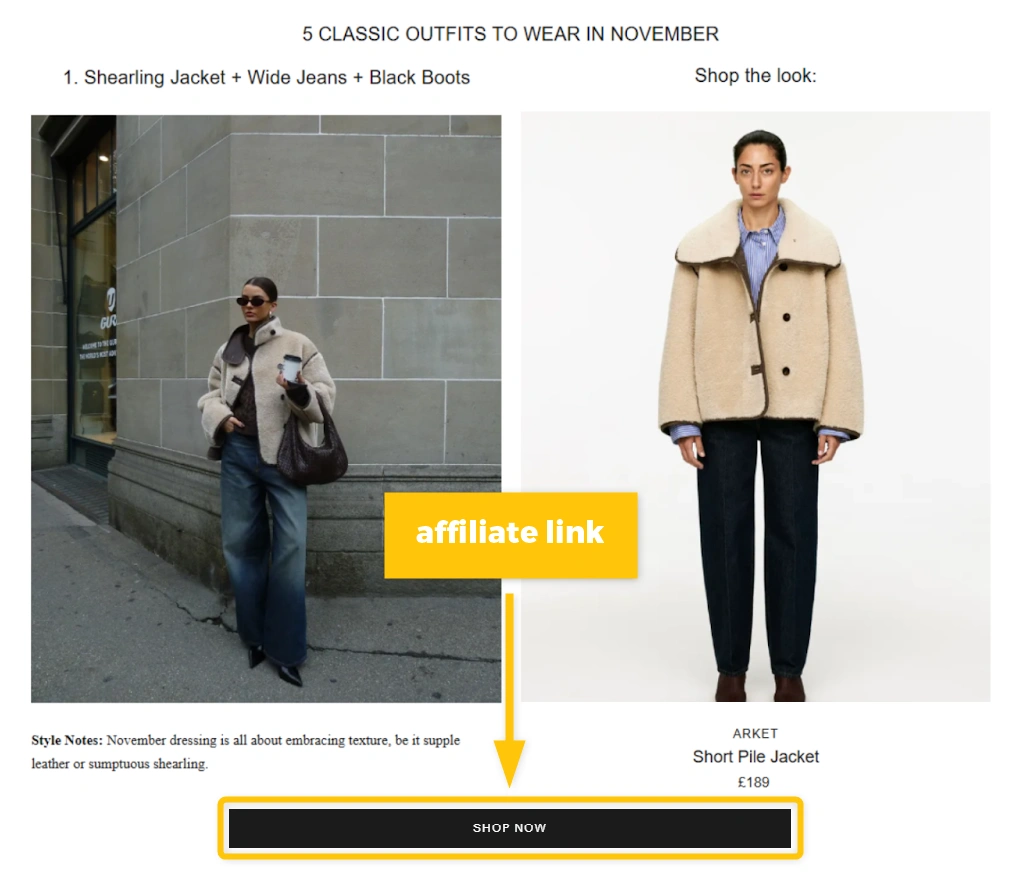
Source: WHO WHAT WHERE
To check whether there are other competitors in the given fashion niche (or how many), you can input their website into Mangools’ SiteProfiler and navigate to the ‘Competitors‘ section to find the website’s top competitors.
There you can find more about top content and backlinks for each competitor, for more in-depth insights.
In addition to that, you can also use the free Mangools Share of Search tool to further analyze the popularity of individual brands in the given industry/niche.
For example, the website we analyzed above is an affiliate for a clothes brand “Arket”.
With Share of Search, you can see Arket’s relative and total share of search in Google over time, and total search amount, which can influence your final decision about partnering with a brand.
3. Perform affiliate keyword research
Now that you know your vertical, niche, and competitors, it is time to start building your affiliate website.
The first thing to do is find relevant keywords to target.
Find top-level keywords
Top-level keywords (seed keywords) are the most important keywords in your vertical/niche that you are trying to rank for with your affiliate website.
These keywords reveal what type of product the user is searching for, rather than a specific brand or model.
They are usually generic, short-tail and affiliates usually try to rank for them with pillar or category pages:
Examples: “gaming laptops”, “kitchen appliances”, “gardening tools”
In addition to seed keywords like these, you can also search for top-level keywords specific to a given affiliate program.
For example, if you have signed up for an affiliate program for vacuum cleaners, you might probably want to try to rank (at some point) for the top-level keywords such as “small vacuum cleaners”, “cheap vacuum cleaners”, or “silent vacuum cleaners”, to maximize your profit from the affiliate program.
During your affiliate keyword research to identify the top-level or category keywords important for your website, you should always check how many people are actually using them to search (keyword volume) and how difficult it is to rank for these keywords (keyword difficulty).
With the Mangools KWFinder, you can easily check the search volumes and KD of all keywords, find related keywords, and have a general overview of the top-ranking competitors in Google SERP.
You might discover even more related keywords that you can potentially rank for – for example brand-specific keywords.
These keywords usually contain some variation of the specific brand + other variables, such as comparisons to competitor brands, phrases related to purchasing the brand’s products, etc.
Keyword variations: “[brand] [product]”, “[brand] vs [competitor]”, “buy [brand] [product]”
Examples: “Dyson vacuum cleaners”, “Bose vs. Sony headphones”, “buy Apple iPhone”
Identify search intents
It’s important to consider the different search intents behind the keywords you’re targeting since search engines rank web pages based on how closely the content on the pages matches the search intent behind the given keywords.
If someone is looking for a concrete solution and your webpage isn’t covering the given topic/solution properly, you probably won’t rank high (or at all) for the important SERPs.
Here is an overview of different intents:
1. Transactional intent
The first category is transactional intent, where users are ready to make a purchase. Keywords like “buy [product],” “purchase [product],” or “[brand] [product] for sale” indicate this high-intent, ready-to-convert mindset.
For these keywords, you’ll want to create and optimize direct product pages with a “ready to buy” option, product information, images, CTAs, etc.
For transactional content, you can prominently feature your affiliate links and calls to action features.
The goal of these pages is to optimize for conversion rate by addressing objections, providing social proof, and securing the top positions on SERP to capture this high-intent traffic.
2. Commercial intent
Keywords with commercial intent might be e.g. “best XY products“, or “product review” where searchers want to check the brands, products, or services first and are not necessarily ready to buy something – they are more exploring and evaluating their options.
For keywords with this type of intent, you might need to create content that presents different products or solutions, giving the user a better overview of their options (e.g., buying guides, comparison pages, product listicles, etc.).
3. Informational intent
Informational intent keywords indicate that users are looking for information, advice, or recommendations (e.g., keywords like ‘how to dress for the fall,’ ‘how to keep your house clean,’ or ‘how to pick winter shoes‘).
For these queries, you’ll want to develop in-depth, educational articles, tutorials, and buyer’s guides that incorporate your affiliate links naturally within the content or internally link to “money pages” that have affiliate links.
The focus here is on providing value and building trust with the audience, as these top-of-funnel users may not be ready to convert immediately, but could become valuable leads down the line.
Ultimately, the goal of affiliate SEO is to rank for transactional, commercial, and informational keywords to capture users at different stages of the purchasing journey and get more traffic.
To see the real search intent behind keywords, you can use Mangools SERPChecker to analyze real-time SERPs for keywords.
For example, for the keyword “best running shoes for women” initially we may think that it is a transactional keyword and that the SERP will only show product pages.
However, with the SERPChecker we see that there is a mixed intent, and some results have lists of shoes in the form of articles while others are product pages.
To compete with the top results, we would have to combine their forms and deliver content that meets this mixed search intent and has some unique advantages over the competitors.
Focus on long-tail keywords
If you are just starting, it is best to focus on long-tail keywords first.
Long-tail keywords, which are more specific and less broad, tend to have lower competition compared to short, generic keywords.
This makes it easier for affiliate marketers to rank for these terms and gain visibility in the search results.
Also, users searching for long-tail keywords typically have a more defined and specific need or intent, which translates to a higher likelihood of conversion, as these users are further along in the buyer’s journey.
This leads to more targeted, high-quality traffic that is more likely to engage with the content and click on the affiliate links.
Here is an example of a long-tail keyword in KWFinder with high search volume and relatively low keyword difficulty:
Prepare a content strategy
Once you have a list of keywords you wish to target, it is time to organize them and create a content strategy.
Your content strategy should be a mix of different intents, so you can appear in various SERPs.
It is also best to start with topics under the same content hub, so you can interlink them and cover them more in-depth.
For example, you can create content hubs for product pages where pages targeting the main top-level keywords would be pillar/category pages and all other long-tail keywords with related products would create “clusters” surrounding (linking to) them.
So for example, for keywords with informational intent, you can create a big guide, trying to cover the top keyword with educational intent and create articles around it covering small keywords/topics.
If you plan on promoting more than one product, it is best to do separate content strategies and create clusters for each one.
It is best to produce content for a while (let’s say three months) and then check the results, and optimize your website more based on the data.
Top keywords for affiliate marketing
Here is a list of the most popular keywords in affiliate marketing based on Mangools KWfinder data:
| Keyword | Global Search Volume |
|---|---|
| Affiliate marketing | 597,000 |
| Affiliates | 317,000 |
| Amazon affiliate program | 284,000 |
| Amazon affiliate | 263,000 |
| Crickex affiliate | 210,000 |
| Mcw affiliate | 175,000 |
| Shopee affiliate | 141,000 |
| TikTok affiliate | 64,100 |
| Fiverr affiliate | 51,900 |
| Temu affiliate program | 35,700 |
4. Create high-quality content
Even though SEO is primarily linked to search engines, the end users and customers will always be people.
Google has emphasized that quality beats quantity and user experience is definitely a ranking factor, especially with the EEAT guidelines.
To convince people to make a purchase, you need to write for people (not for search engines), follow EEAT guidelines, create in-depth content that is part of a bigger picture (content hub), and focus on users having an intuitive and smooth experience on your website.
High-quality content is hard to define, but avoiding repetitive phrases, AI-generated content, misleading texts or keyword stuffing is a good start.
You can boost authority with author pages and bylines, unique research and statistics, graphics, and custom images while providing your own perspective and genuine opinions.
5. On-page optimization
On-page optimization helps affiliate pages to improve their relevancy for chosen keywords in Google Search as well as encourage potential customers to click on the organic snippet in SERPs.
By increasing click-through rates, reducing bounce rates, enhancing dwell time, aligning with search intent, and improving user experience, on-page SEO techniques help affiliate websites with rankings, traffic, and conversions.
Here is the overall on-page checklist you can follow:
- Optimize your title tags and meta descriptions to let search engines and readers know what they can expect from the webpage.
- Organize your page content hierarchy into H1s, H2s, and H3s to make it more skimmable and understandable to users and search engines.
- Avoid text-heavy paragraphs – make sure they are 2–3 rows max
- Make sure the URL slug is user-friendly and is a variation of the main keyword
- Add target keywords to your body content but avoid keyword stuffing and unnatural phrasing
- Implement product, review, and aggregate rating schemas to appear in rich snippets or knowledge panels, and provide more product information for readers
- Make sure to internally link webpages to build content hubs and clusters to boost authority in the eyes of search engines. If topics are connected, search engines will treat your website as an expert in the given topic, while interested readers will more likely spend time on your website
For internal linking, it is efficient to connect your top-of-the-funnel (ToFu) and middle-of-the-funnel (MoFu) content with bottom-of-the-funnel (BoFu) content.
In that way, you will drive organic traffic from informational content to commercial/transactional pages, increasing your conversion rate and time spent on the website.
6. Perform regular SEO audits
Regular SEO audits help evaluate the on-page/technical SEO state of the website, to ensure all “obstacles” on your website are removed, so both users and crawlers have a good experience once they land.
Here is how to perform a basic SEO audit:
- Check your on-page SEO tags: Use the Mangools SEO extension as a tool for analyzing individual pages.
- Run a full site crawl with Screaming Frog to identify website errors, such as broken links, privacy errors, etc
- Check your Core Web Vitals to see site speed and mobile friendliness
- Perform a backlink audit to find lost or spammy links
- Remove low-quality, zombie, or orphan pages.
- Optimize your web pages for UX signals
- Analyze your competitor’s content to find gaps
- Update your content with new insights, examples, images
- Optimize for featured snippets
- Replace low-quality or blurry images
- Analyze your site’s topical authority and update your content strategy accordingly
7. Focus on link-building
Acquiring backlinks gives search engines the “thumbs up” that your website is useful and helpful to others.
However, spammy backlinks can hurt your website if Google notices they’ve been acquired through link farms or black SEO techniques.
The best ways to ensure a genuine backlink is through these popular link-building techniques:
- Guest posts or quotes: Write a full guest post or add an original quote on other relevant websites and request a backlink to your website.
- Case study or statistics data: Make a research paper with original data that others will link to when needing specific examples in your niche.
- Mentions: Track your mentions and see if some websites have mentioned yours, without a backlink. Then reach out and ask the administrators to add it.
To find high-intent websites to build your backlinks, check out your competitor’s backlink profile with Mangools LinkMiner.
Just input the website and click on “Find backlinks”. You can then see lost links, nofollow and dofollow links, new links, etc, all in one dashboard.
8. Conversion optimization
Your affiliate links need to be visible to the reader, but at the same time not overwhelm them.
Therefore, they need to fit the website “naturally”, and here are a few examples:
a) Contextual links
Contextual affiliate links are placed in the body of the text once you mention the product.
The body of the text should provide further information and promote the product before the actual link.
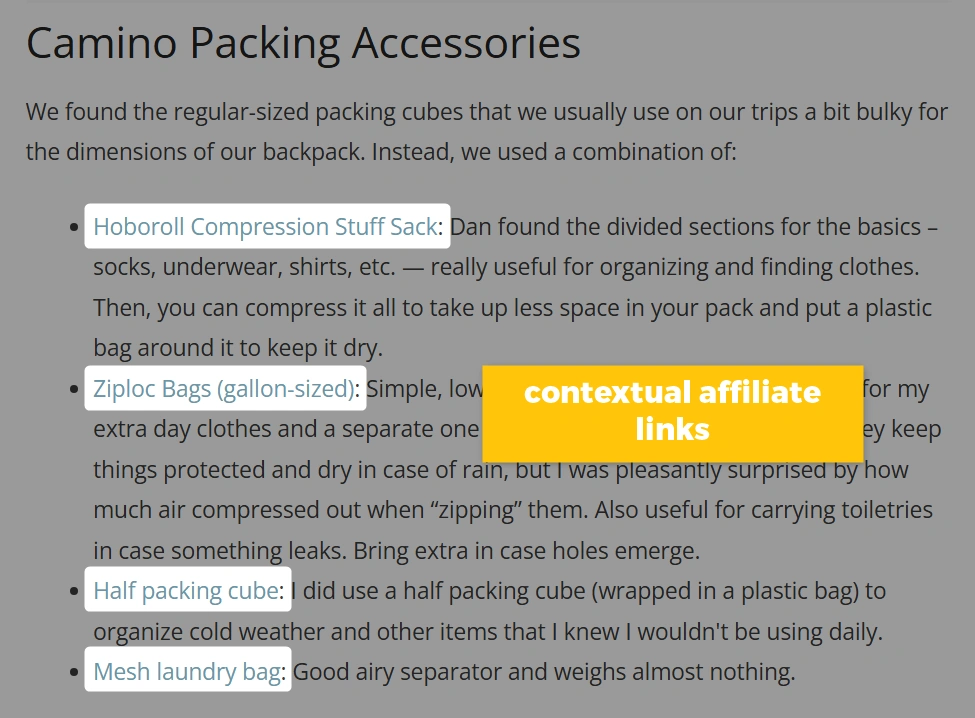
Source: Uncornered Market
b) CTA buttons and banners
You can add a CTA button or banners with the affiliate link at the beginning, middle, or end of the webpage, wherever it seems like a good fit.
These visual elements can usually grab the attention of readers faster than contextual links, but they shouldn’t be too overwhelming.

Source: Indie Traveller
c) Separate sections
The last option is to add a separate section with all your product affiliate links by the end of the page.
This method is the least intrusive, but you risk losing potential conversions if the reader doesn’t reach the end of the page before leaving.

Source: Expert VagaBond
Are affiliate links bad for SEO?
Google’s official stance is that affiliate links are generally acceptable, but they should be properly disclosed and not overshadow the main content on the webpage.
Avoid techniques that may be seen as deceptive, such as cloaking or tricking users. Be upfront about paid placements or sponsored content.
“It is not necessary to hide affiliate links for search engines, no need for weird automatic JavaScript or cloaking to hide them, just link and declare them so they can be treated properly.” (John Muller, Google Search Advocate)
In the article: “A reminder on qualifying links and our link spam update” from Google, it is stated that using affiliate links for monetizing is fine, as long as they are qualified with “rel="nofollow"” and “rel="sponsored"” attributes:
Regular link: <a href="https://www.example.com/product-page">Product Features</a>
Affiliate link: <ahref="https://www.sephora.com/product/saie-mini-dew-blush-trio-P513206" rel="nofollow sponsored">Check Price on Sephora</a>
The key difference between these 2 link examples is that the affiliate link has the “rel="nofollow sponsored" attributes, indicating it’s a paid/sponsored link that should not pass full link equity (or PageRank).
In addition to that, affiliate links should not look spammy or out of context on your website.
They should be integrated naturally into your content, using proper anchor text that is relevant and descriptive.
For example, a regular internal link might say “Read more about our product features”, while an affiliate link could say “Check the latest price on Amazon”.
Lastly, we recommend following FTC guidelines on disclosing sponsored content, and affiliate-network rules, in your statement which explains the nature of your relationship with companies that pay you to sponsor and promote their products.
9. Monitor website performance
To regularly monitor the SEO performance and conversions of your affiliate websites, you need to have Google Search Console (GSC), Google Analytics 4 accounts, and a tool such as the Mangools SERPWatcher.
1. Connect your website to GSC, and monitor traffic (impressions and clicks) for individual pages.
2. Connect your affiliate website to GA4, and set events to monitor conversions and bounce rates for your web pages.
3. Use the Mangools SERPWatcher to track your keyword rankings in real time:
- Just enter your domain, location, and search platform.
- Add the target keywords that you want to monitor
The keywords will be added to a tracking report, which you can easily access and check your website rankings and performance.
10 SEO tips for affiliate marketing
Here are ten best practices for affiliate marketers to withstand any future algorithm change.
- Choose a good domain name
- Focus on commercial & transactional keywords
- Create mobile-friendly web pages
- Optimize for voice search
- Adjust content for featured snippets
- Combine SEO with SEM
- Promote your website on social media
- Pay attention to the seasonality of keywords
- Update your content regularly
- Check out Mangools SEO affiliate program
1. Choose a good domain name
When picking a domain name, focus on creating something simple and memorable that’s under 10 characters and easy to spell.
While incorporating a relevant keyword can boost SEO, don’t force it or resort to keyword stuffing – practices like “best-cheap-shoes-online.com” look spammy and can hurt your credibility.
You should also go for a “.com” top-level domain (TLD) whenever possible, as it remains the most recognized and trusted domain extension. If you’re looking for quality domain options, consider exploring premium domain inventory that offers established domains with clean histories.
Before finalizing your choice, thoroughly check for trademark conflicts and verify the availability of matching social media handles to maintain consistent branding.
Research the domain’s history using tools like DomainTools and WaybackMachine to ensure it wasn’t previously used for spam or hit with Google penalties.
A clean history is crucial for your site’s search engine performance.
a) For DomainTools, just enter the domain name and you can see the full ownership history. Check historical WHOIS records, DNS changes, hosting history, and even past IP addresses.
b) With the WaybackMachine, you can see older versions of the website, and check if the content on the potential domain was spammy or if the website owners used black-hat SEO techniques in the past – just enter the domain name in to the tool:
Here is a quick comparison of the whowhatwear.com website, as an example, in 2012 vs. 2024:
Finally, don’t forget to check the backlink profile of the website to see if it has been associated with “prohibited” niches or link farms.
2. Focus on commercial & transactional keywords
By focusing on transactional keywords, you can position your affiliate content to capture users who are ready to convert.
Intentionally create content optimized for these types of commercial keywords to attract users who are likely to click affiliate links and make purchases
Some key examples of valuable transactional keywords include “buy [product] online,” “where to buy [product],” and “[product] price” variations. These terms demonstrate that the user is actively searching to purchase a specific item.
Similarly, price-related keywords like “cheap [product],” “[product] deals,” and “[product] coupon” indicate the user is looking for the best value.
Review and comparison terms such as “best [product]” and “[product] vs [competitor]” show the user is evaluating options to make a purchase decision.
Geo-targeted or local keywords like “[product] near me” and “[city] [product] stores” suggest the user is looking to buy locally.
Highlighting specific product features, models, or seasonal availability can also capture users with transactional intent.
3. Create mobile-friendly web pages
Ever since Google announced “The Speed Update” and “Mobile-first indexing update“, mobile-friendly web pages have become the top priority.
Mobile optimization goes beyond simply having a responsive layout that adjusts to smaller screens.
It requires thoughtful UX design to ensure seamless navigation, quick page load times, and friction-less conversion flows.
Affiliate sites need to be made to smoothly guide mobile users through the purchase funnel, from browsing products to clicking affiliate links.
Clunky interfaces, sloppy formatting, and slow loading speeds will cause high bounce rates and prevent mobile visitors from converting.
Key mobile optimization strategies include minimizing page elements, compressing image and media files, and implementing AMP (Accelerated Mobile Pages) if necessary.
Affiliate sites should also consider mobile-specific content formatting, such as vertical product image carousels and thumb-friendly click targets for affiliate CTAs.
4. Optimize for voice search
Around 40 million people in the US will use voice search for shopping by the end of 2025, according to EMARKETER’s forecast.
Therefore, affiliate websites should optimize content for voice search as well.
Voice search queries tend to be longer, more conversational, and focused on local intent or immediate purchasing needs.
To capture this growing segment of online consumers, affiliate marketers should adjust their content and technical infrastructure accordingly. Here is how:
1. Create content that directly answers common voice search queries related to your product offerings. This may involve creating short, featured snippet-ready responses to questions like: “What’s the best [product] for [use case]? Or “Where can I buy [product] near me?”
2. Affiliate sites should rank for long-tail, conversational keywords such as “I’m looking for an affordable [product]” or “Show me reviews of [product brand].” Incorporate schema markup to increase the visibility of this type of intent-driven content to improve voice search optimization.
3. Ensuring fast page load times, mobile responsiveness, and a clean site architecture are critical for voice search success. Voice queries often trigger direct answers from search engines, so your affiliate website should be structured to deliver this information right away. Use accelerated mobile pages (AMP) and implement structured data to stand out in voice search results.
For example, an affiliate site in the home security niche might optimize for voice searches like “What’s the best home security system for a small apartment?” by providing a concise, featured-snippet-ready response highlighting its top-recommended product.
The site could then link to a dedicated product page optimized with relevant schema markup to capture voice-based purchase intent queries such as “Where can I buy the XYZ home security system?”
5. Adjust content for featured snippets
Featured snippets are the concise, directly-answered summaries that appear at the top of search engine result pages, often triggered by voice search queries.
By structuring affiliate content to directly address search intent and deliver clear informative responses, you can increase the chances of your pages being featured prominently.
Key tactics include:
- Identifying high-intent, question-based keywords relevant to your affiliate products (e.g. “What is the best [product] for [use case]?”)
- Providing clear, concise answers to these questions in a format that search engines can easily scrape, such as a step-by-step list or a pros/cons comparison table
- Optimizing content with proper headings, bullet points, and schema markup to signal the page’s structure and relevance
- Providing comprehensive, authoritative information that fully addresses the search query
- Testing different content formats and lengths to see what performs best for featured snippet eligibility.
6. Combine SEO with SEM
To complement SEO efforts, SEM tactics like pay-per-click (PPC) advertising on search engines help affiliate websites gain additional visibility and reach users higher in the purchase funnel.
Especially if you are targeting high KD or short-tail keywords.
Paid search campaigns allow affiliate marketers to target specific, commercially driven keywords that may be too competitive to rank organically.
This can include branded terms, high-intent buying phrases, and even remarketing to previous site visitors.
7. Promote your website on social media
Interconnecting your websites and social media helps you reach a wider audience and boost awareness.
Investing in your affiliate website should be the base for all other activities, and you can repurpose content for your stories, feeds, or social media ads.
In that way you can capture a portion of the audience that isn’t actively looking for a solution, but after seeing your offer a couple of times they might reconsider.
8. Pay attention to the seasonality of keywords
Many product categories experience significant spikes in search volume and purchase intent at certain times of the year, such as the holiday shopping season or the start of a new school year.
By aligning content and promotions with these seasonal fluctuations, affiliate sites can position themselves to capture a larger share of that increased demand.
For example, create seasonal content and offers that are aligned with the search intent and purchasing behaviors of their target audience during the season.
This could involve highlighting holiday gift guides, back-to-school product recommendations, or seasonal product discounts.
Affiliate sites using paid search advertising should be aware that keyword seasonality is very important for budgeting and bidding strategies.
Here is an example from KWFinder, of how the search volume trend for the keyword “Christmas stockings” changes over the year, with approximately a +22% spike in October/November.
Allocating more ad spend during peak seasons and adjusting bids accordingly can maximize ROAS, while pulling back during off-seasons prevents wasted spend.
9. Update your content regularly
A general rule is to update your content every three months based on your metrics and the SERP analysis.
However, if you are tracking your keywords with Mangools, you can automatically update content whenever you see a drop in rankings or a change of intent in the SERPs.
Make sure you don’t just update the date of posting and add new keywords, but truly perform a mini competitor and SERP research to see what you can add to stand out and attract readers.
10. Check out the Mangools SEO affiliate program
If you are looking for an affiliate program in your SaaS niche, you can earn more than $600/month with our Mangools affiliate program!
By promoting our SEO tool, you can earn up to 35% lifetime commissions each time an auto-renewal payment is made.
Here is what you will get after joining the Mangools SEO affiliate program:
- Super easy to get started – no approval process required for registration.
- Lifetime earnings – earn from 25% up to a 35% commission for every monthly or annual payment made by a user through your affiliate links.
- Tiered system that can increase your earning potential.
- High conversion rate – more than 67% of people who tried our SEO suite decided to subscribe in less than 24 hours after registration.
- Free promo materials – static/dynamic banners, images, colors, everything is already set for you! You can even create a FREE account and try our tools to better demonstrate the power of our SEO tools.
Tip: Speaking of affiliate programs – with Black Friday and Cyber Monday in full swing, now’s the perfect moment to jump in and promote special deals. Don’t miss out on these current SaaS-related Black Friday offers, which make great affiliate link candidates:
Frequently asked questions
Is SEO good for affiliate marketing?
Yes, SEO is nowadays highly necessary for affiliate marketing websites.
By optimizing your website and content for search engines, you can drive consistent, targeted traffic to your affiliate offers, leading to more sales and commissions.
Without SEO, there is little to no chance your customers will find your affiliate website.
What are affiliate links?
Affiliate links are unique, trackable URLs provided by merchants or affiliate networks.
When a customer clicks on an affiliate link and makes a purchase, the affiliate marketer earns a commission on that sale (but usually isn’t in charge of the post-purchase process).
Are affiliate backlinks bad for SEO?
No, affiliate backlinks aren’t necessarily bad for SEO.
However, it’s important to ensure that the backlinks are from high-quality, relevant sources and that your website is not over-optimized with too many affiliate links, which could be seen as spammy by search engines.
Google’s representatives say they are fine with affiliate links as long as the page can stand on its own and the links have appropriate attributes.
How to rank an affiliate website?
To rank an affiliate website, focus on creating high-quality, informative content that targets relevant keywords, optimize your on-page SEO, build a diverse portfolio of backlinks, and continuously monitor and improve your site’s technical performance and user experience.
Is PPC or SEO better for affiliate marketing?
PPC can provide faster, more immediate results through targeted ad campaigns, but it requires an ongoing investment in advertising costs.
SEO, on the other hand, offers more sustainable, long-term traffic growth, but it takes more time and effort to build up organic rankings.
Combined, SEO can boost PPC campaigns and aid in delivering more conversions.


